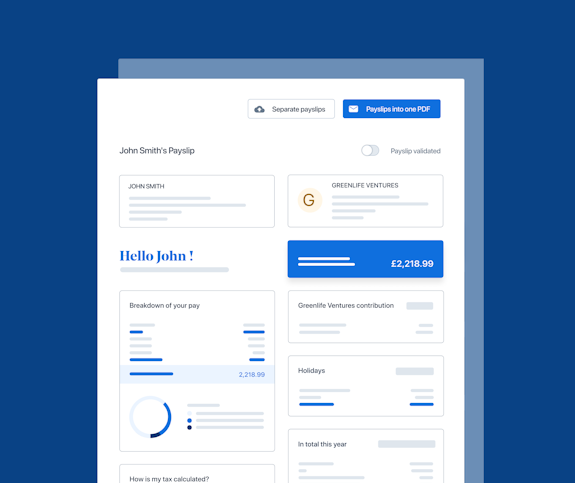- Blog
- |Managing Payroll
- >Payroll legislation
- >key changes for the 2024/2025 tax year
8 Key Changes for 2024/2025 Tax Year


It’s that time of year again.
As one tax year comes to a close, another one begins. More often than not, that usually means new tax changes and regulations coming into effect.
Whether you’re the type of person who absolutely geeks out on this kind of stuff or the words ‘tax changes’ make you want to run a mile, know that you can count on our in-house CIPP payroll experts and us to break things down. We aim to be your go-to source for new tax year information for payroll.
Let’s look at what’s changing in the new 2024/2025 tax year.
PayFit Top Tip:
This time of year tends to get busy, so the earlier you start to prepare, the smoother things will go.
Eight key changes to action this new tax year
Here are eight new tax year changes from HMRC that we know of so far to look out for in 2024. For more general information on wrapping up the current tax year, check out this overview on preparing for the new tax year.
National Minimum Wage (NMW)/ National Living Wage (NLW) rates confirmed
First up on the agenda is the National Minimum Wage.
Inflation and the Cost of Living Crisis still make this a vital issue to tackle across the UK.
This year, the government has done away with the 21-22 age bracket, so employees aged 21+ must receive the National Living Wage. They’ve also bumped the rate from £10.42 to £11.44 per hour, per announcements made during the Autumn Statement.
See the table below for new rates and how they’ve changed from last year.
| Age | Change | Hourly rate |
|---|---|---|
| 21+* | ⬆️ | £11.44 |
| 18-20 | ⬆️ | £8.60 |
| Under 18 | ⬆️ | £6.40 |
| Apprentice under 19 or over 19 and in first year of apprenticeship | ⬆️ | £6.40 |
Statutory leave rates also confirmed
As with minimum wage, another increase in statutory pay has also been announced for the new 2024/2025 tax year.
From April 2024, there will be new rates for statutory maternity and other parental pay and sick pay, as well as other benefits for employees who qualify.
The first six weeks of Statutory Maternity Pay (SMP) and Statutory Adoption Pay (SAP) will remain the same at 90% of average weekly earnings (AWE). After this, employees can expect a statutory weekly rate of 90% of AWE or £184.03, whichever is lower.
It’s worth noting that this new rate should be applied on Sunday, the 7th of April, and paid for the full statutory week that the Sunday falls before. You can find out more details about this on the PayFit Help Centre.
The same change applies to Statutory Paternity Pay (SPP), Statutory Shared Parental Pay (ShPP) and Statutory Parental Bereavement Pay (SPBP) - the statutory weekly rate for these will be the lower of 90% of AWE or £184.03.
There is also a new weekly rate for Statutory Sick Pay (SSP) of £116.75, which comes into effect on the 6th of April.
| Statutory payment | Change | Rate |
|---|---|---|
| Statutory Paternity Pay (SPP) | ⬆️ | £184.03 |
| Statutory Maternity Pay (SMP) | ⬆️ | £184.03 |
| Shared Parental Pay (ShPP) | ⬆️ | £184.03 |
| Statutory Bereavement Leave (SBP) | ⬆️ | £184.03 |
| Statutory Adoption Pay (SAP) | ⬆️ | £184.03 |
| Statutory Sick Pay (SSP) | ⬆️ | £116.75 |
Additional changes to Statutory Paternity Leave (SPL)
Fathers who are either expecting or adopting used to have to take their 2-week block of allotted paternity leave as one single block.
But starting in the new tax year, new fathers can take these weeks either together or separately. Employees must give 28 days' notice before any block of leave and notify their employees if they wish to change the start date.
Holiday pay and entitlement for zero-hour employees
In previous years, rolling up holiday pay was unlawful. But as of the new leave year, which starts on the 1st of April 2024, employers can ‘top up’ employee earnings in any specific pay period at a rate of 12.07%. In other words, rolled-up holiday pay is now lawful for zero-hour or part-year workers.
This applies only to cases where the employee has had no statutory parental or sick leave that month. If an employee has had statutory, parental or sick leave in the current month, then the average pay should be calculated using gross pay taken over the previous 52 weeks. This means they’ll receive 12.07% of total earnings in the period related to weeks worked, plus an additional top-up for pay not received for periods of statutory parental or sick leave.
Alternatively, employers can also choose to set up an accrual for these kinds of employees, also using the 12.07% rate based on hours worked over the last 52 weeks. This way, employees can receive holiday pay at the time they take their annual leave, instead of receiving a portion of holiday pay each month.
Investment zones and specialist tax sites (NI categories and thresholds)
Perhaps this is one of the bigger new tax year changes for businesses announced by the UK government.
The tables below outline the new NIC categories for rates* and thresholds. Please note these apply to employee NIC only. They also apply to what’s being referred to as ‘specialist tax sites’; in other words, freeports and investment zones. While freeports already existed, investment zones were introduced during the Chancellor’s 2023 Autumn Statement.
To start, you’ll want to check if your business is firstly a freeport or investment zone, that is, if you haven’t already done so. If it is, you’ll want to check that you’re using the proper NI categories and rates.
You can review all the new thresholds and rates in the tables below.
*For this particular rate change, you’ll definitely need to get in touch with your payroll provider in order to check how to apply these rates.
Reminder
As of the 6th of January 2024, the main NI rate has been cut by two percentage points.
| Threshold | Change | Monthly | Annual |
|---|---|---|---|
| Lower earnings limit (LEL) | ➡️ | £533 | £6396 |
| Primary Threshold (PT) | ➡️ | £1,048 | £12,570 |
| Secondary Threshold (ST) | ➡️ | £758 | £9,100 |
| Upper Earnings Limit (UEL) | ➡️ | £4,189 | £50,270 |
| Upper Secondary Threshold (UST) | ➡️ | £4,189 | £50,270 |
| Apprentice Upper Secondary Threshold (AUST) | ➡️ | £4,189 | £50,270 |
| Veterans Upper Secondary Threshold (VUST) | ➡️ | £4,189 | £50,270 |
| Investment Zone Upper Secondary Threshold (IVUST) | 🆕 | £2,083 | £25,000 |
| Freeport Upper Secondary Threshold (FUST) | ➡️ | £2,083 | £25,000 |
| NI category | LEL to PT | PT to UEL | Above UEL |
|---|---|---|---|
| D - Investment zone (deferment) | 0% | 2.00% | 2.00% |
| E - Investment zone (married woman or widow entitled to pay reduced NICs) | 0% | 3.85% | 2.00% |
| F - Freeport (standard category) | 0% | 10.00% | 2.00% |
| I - Freeport (married woman or widow entitled to pay reduced NICs) | 0% | 3.85% | 2.00% |
| K - Investment zone (over state Pension Age) | 0% | 0.00% | 0.00% |
| L - Freeport (deferment) | 0% | 2.00% | 2.00% |
| N - Investment zone (standard category) | 0% | 10.00% | 2.00% |
| S - Freeport (over State Pension Age) | 0% | 0.00% | 0.00% |
| NI category | Below FUST or IVUST | Above FUST or IVUST |
|---|---|---|
| Specialist tax sites D,E,F,I,K,L,N,S | 0% | 13.80% |
New Scottish tax band and thresholds
While there is no rate or threshold change for rUK and Wales, a new tax band has been introduced for Scotland. Named the Scottish Advanced Rate, this new band has been squeezed in between the existing Higher Rate and the Top Rate. The new Advanced Rate is 45%, while the Top Rate has increased to 48%.
Additionally, thresholds for all but the Top Rate have changed.
| Band | Rate change | Rate | Threshold change | Annual threshold |
|---|---|---|---|---|
| Scottish Starter Rate | ➡️ | 19% | ⬆️ | £1-£2,306 |
| Scottish Basic Rate | ➡️ | 20% | ⬆️ | £2,307-£13,991 |
| Scottish Intermediate Rate | ➡️ | 21% | ⬆️ | £13,992-£31,092 |
| Scottish Higher Rate | ➡️ | 42% | ⬆️ | £31,093-£62,430 |
| Scottish Advanced Rate | 🆕 | 45% | 🆕 | £62,431-£125,140 |
| Scottish Top Rate | ⬆️ | 48% | ➡️ | £125,141+ |
Increased student loan thresholds
The thresholds at which employees start to pay student loans for Plans 1 and 4 have increased. There is no change for Plan 2.
Changes to post-graduate loans have yet to be announced.
| Plan type | Rate | Threshold change | Monthly | Annual |
|---|---|---|---|---|
| 1 | 6% | ⬆️ | £2,082.5 | £24,990 |
| 2 | 6% | ➡️ | £2,274.58 | £27,295 |
| 4 | 6% | ⬆️ | £2,616.25 | £31,395 |
| Post-graduate loan | 0% | ➡️ | £1,750 | £21,000 |
Decrease in directors’ NI ‘main rates’
From the beginning of January, the hybrid rate applies to directors, but from April, this should match the rate used for employee NI calculations.
Essentially, this means the directors’ ‘main rates’ for NI will move back down to match employee rates. The rates used will depend on the NI category. Some directors may no longer be able to use the main rate at all.
Three other legislation reforms are coming into play
Entitlement for carer's leave
From 6 April 2024, employees have a statutory entitlement, from day 1 of their employment, to take up to one week of unpaid carer’s leave per year. The leave can be taken in half days (minimum) or full days, but no more than one week per year. It also doesn’t need to be taken on a consecutive basis.
This new type of leave will work on a 12 month rolling basis, and employees should provide notice that is at least as many days as the period of leave. For example if they want to take 2 days of leave, they should provide 2 days’ notice, though employers can choose to waive this requirement.
Additional free hours of childcare
During last year’s Autumn budget, the Chancellor also announced new measures to allow working parents to claim free childcare. Parents with children between one and two years old will be able to claim up to 30 hours a week back. This initiative is to be rolled out in phases as outlined by the government.
Flexible working legislation
The beginning of the new tax year will see new flexible working legislation coming into effect.
From this date, employees will be entitled to request flexible working arrangements from day one of their employment. In previous years, an employee would have had to work 26 weeks before putting in a flexible request. It’s important that businesses become familiar with this new initiative so they can make any necessary updates to their policies.
Special announcement: payrolling benefits will become mandatory…
The changes we’ve covered so far have all been applicable to the new 2024/2025 tax year but we thought it might be worth sharing this recent news as well.
From the the 6th of April 2026, payrolling benefits will become mandatory.
For businesses not yet enrolled onto this scheme, this is where employees pay their tax on benefits (and sometimes Class 1 NI) directly through payroll in real-time. The alternative has been to submit P11Ds directly to HMRC by the 6th of July of the new tax year, but this method will be discontinued in 2026.
Are you ready for the new tax year?
At PayFit, we’ve baked payroll compliance into every single part of our solution.
Our clients rest easy, knowing their monthly payroll will be fully compliant, even if they’re not up to speed with all the latest changes from HMRC.
You can run your payroll seamlessly, from automating payroll and HMRC submissions to producing HR and finance reports explicitly tailored to your organisation. No painstaking manual processes needed.
And to make it a little easier we have our checklist that provides you with all the important deadlines you need to know for the end and start of the tax year.


A UK 4-Day Working Week - Thoughts On Labour’s Plan

Running payroll - A Guide For New Businesses

The Alabaster Ruling & Maternity Pay - A Guide For Employers

The End Of Zero Hours Contracts? Implications For Businesses

What is the HM Revenue and Customs Starter Checklist

